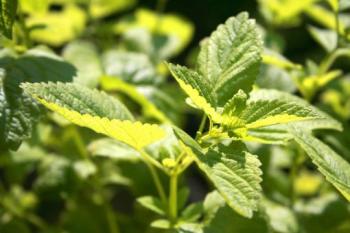The word “Melissa” is of Greek origin and means bee. Beekeepers in antiquity treasured these plants for their ability to nourish the bees.
The perennial lemon balm shrub emerges from the soil during the springtime, showing off its bright green, fragrant leaves in the gardens. Requiring primarily morning sun, the herb doesn’t need a garden to flourish; it can grow in a large pot. The plant will produce new leaves into the fall if the uppermost shoots are cut back.
If you lack a place to keep the potted plant over the winter, simply place it somewhere in nature where you go for walks, and enjoy its emerging beauty again the following spring. If you have found a pollution-free spot, you can consume and enjoy the plant to its fullest.
Lemon balm came to continental Europe from southern Europe via North Africa in the 11th century. Monks introduced the plant into their monastery gardens, and naturalist Plinius (A.D. 23––79) recommended the plant as an aid to counteract hypochondria, and hysterics.
Hildegarde of Bingen also prescribed the plant’s lemon-scented, mood-elevating properties. In 1611, Carmelite nuns created “Klosterfrau Melissengeist” (“Nun’s Balm Spirits”) as a tonic for heart problems.
Its essential oils, bitter properties, and tannins account for the healing effects. Nevertheless, the high alcohol content of the lemon balm spirit is detrimental to long-term use. A tea made from lemon balm is a better option for those who suffer from changes in barometric pressure (weather changes) or mild depression.
Some medical practitioners recommend lemon balm as an aid to treat psychosomatic symptoms of the stomach or digestive tract or to alleviate nervous sleep disturbances. Aside from that, chopped lemon balm leaves are a tasty addition to salads or fish and potato dishes.
Sugared lemon balm leaves are a particularly tasty treata little: Brush beaten egg white over the leaves, then laying them onto a board that has been sprinkled with white sugar, sprinkle the tops of the leaves with additional white sugar. Leave them to dry, and in about two hours, one has a candied confection that is an elegant, tasty décor for tortes, and other desserts.
The sugar left on the board has absorbed some of the balm’s essential oils and is suitable for all manner of desserts. Stored between waxed paper, these sugared leaves keep for several weeks. Placed into a nice glass jar, they make an unusual hostess gift.
Another gift idea: Sew simple, small bags from a light fabric, leaving one side open. Fill these fairly full with dried lemon balm leaves, and sew the open end closed. Place these little pillows close to your bed pillow as a relaxing refresher after a hard day. This little pillow gives off its lemony scent anew each time it is used.







Friends Read Free